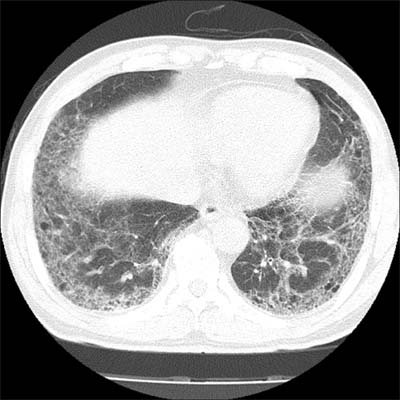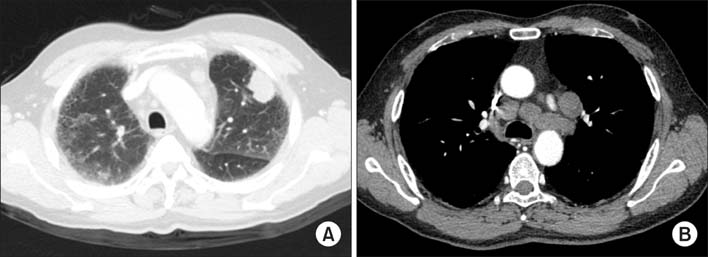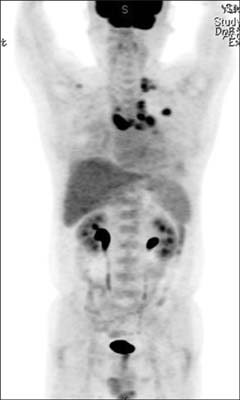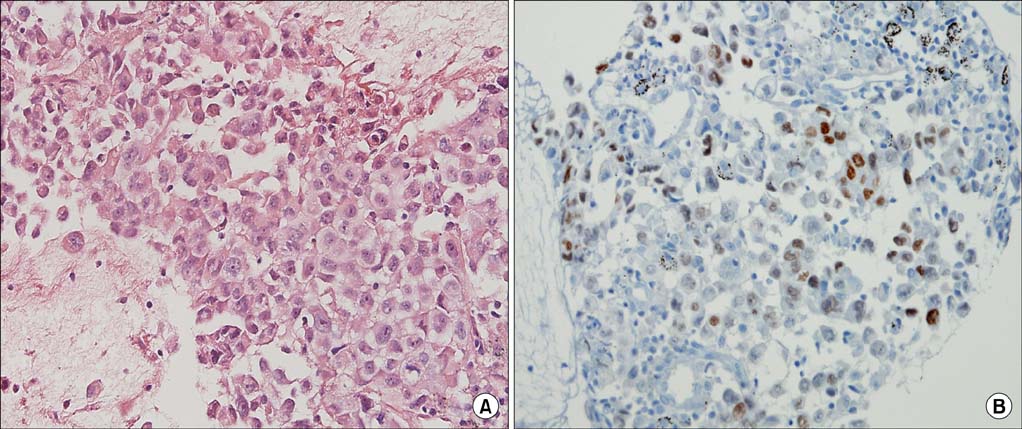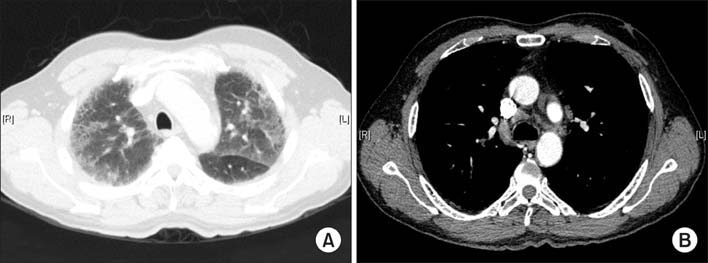Tuberc Respir Dis.
2013 Nov;75(5):214-217.
Spontaneous Regression of Non-Small Cell Lung Cancer in a Patient with Idiopathic Pulmonary Fibrosis: A Case Report
- Affiliations
-
- 1Division of Pulmonology and Critical Care Medicine, Department of Internal Medicine, Institute of Chest Disease, Yonsei University College of Medicine, Seoul, Korea.
- 2Department of Pathology, Yonsei University College of Medicine, Seoul, Korea.
- 3Department of Internal Medicine, National Health Insurance Service Ilsan Hospital, Goyang, Korea. tocari@hanmail.net
Abstract
- Treatment of lung cancer in patients with idiopathic pulmonary fibrosis (IPF) is difficult because the mortality rate after surgery or chemotherapy is high for these patients. Spontaneous regression of cancer is rare, especially in lung cancer. A 62-year-old man, previously diagnosed with IPF, presented with stage IIIC (T2N3M0) non-small cell lung cancer. About 4 months later, spontaneous regression of the primary tumor was observed without treatment. To the best of our knowledge, this is the first report of spontaneous regression of lung cancer in a patient with IPF.
MeSH Terms
Figure
Reference
-
1. Park J, Kim DS, Shim TS, Lim CM, Koh Y, Lee SD, et al. Lung cancer in patients with idiopathic pulmonary fibrosis. Eur Respir J. 2001; 17:1216–1219.2. Hubbard R, Venn A, Lewis S, Britton J. Lung cancer and cryptogenic fibrosing alveolitis: a population-based cohort study. Am J Respir Crit Care Med. 2000; 161:5–8.3. Le Jeune I, Gribbin J, West J, Smith C, Cullinan P, Hubbard R. The incidence of cancer in patients with idiopathic pulmonary fibrosis and sarcoidosis in the UK. Respir Med. 2007; 101:2534–2540.4. Cole WH, Everson TC. Spontaneous regression of cancer: preliminary report. Ann Surg. 1956; 144:366–383.5. Isobe K, Hata Y, Sakamoto S, Takai Y, Shibuya K, Homma S. Clinical characteristics of acute respiratory deterioration in pulmonary fibrosis associated with lung cancer following anti-cancer therapy. Respirology. 2010; 15:88–92.6. Lee YS, Kang HM, Jang PS, Jung SS, Kim JM, Kim JO, et al. Spontaneous regression of small cell lung cancer. Respirology. 2008; 13:615–618.7. Lee JK, Kim DJ, Won TS, Park SH, Son HS, Cho SJ. A case of spontaneous regression of non-small-cell lung cancer. Tuberc Respir Dis. 2009; 66:42–46.8. Hong SH, Park SM, Shin TR. A case of partial spontaneous regression of non-small cell lung cancer. Tuberc Respir Dis. 2009; 66:132–135.9. Kappauf H, Gallmeier WM, Wunsch PH, Mittelmeier HO, Birkmann J, Buschel G, et al. Complete spontaneous remission in a patient with metastatic non-small-cell lung cancer. Case report, review of the literature, and discussion of possible biological pathways involved. Ann Oncol. 1997; 8:1031–1039.10. Moriyama C, Yamazaki K, Yokouchi H, Kikuchi E, Oizumi S, Nishimura M. A case of spontaneous remission of large cell carcinoma of the lung with brain metastasis. Jpn J Lung Cancer. 2008; 48:112–117.11. Nakamura Y, Noguchi Y, Satoh E, Uenaka A, Sato S, Kitazaki T, et al. Spontaneous remission of a non-small cell lung cancer possibly caused by anti-NY-ESO-1 immunity. Lung Cancer. 2009; 65:119–122.12. Pujol JL, Godard AL, Jacot W, Labauge P. Spontaneous complete remission of a non-small cell lung cancer associated with anti-Hu antibody syndrome. J Thorac Oncol. 2007; 2:168–170.
- Full Text Links
- Actions
-
Cited
- CITED
-
- Close
- Share
- Similar articles
-
- A Case of Spontaneous Pneumomediastinum and Pneumopericardium in a Patient with Acute Exacerbation of Idiopathic Pulmonary Fibrosis
- A Case of Partial Spontaneous Regression of Non-Small Cell Lung Cancer
- Lung Cancer in patients with Idiopathic Pulmonary Fibrosis: Frequency and CT Findings
- A Case of Spontaneous Regression of Small Cell Lung Cancer
- A Case of Spontaneous Regression of Non-small-cell Lung Cancer

